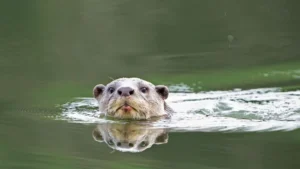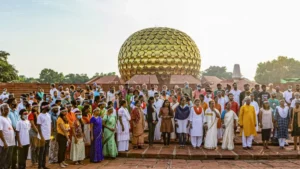In a landmark decision to conserve unique ecosystems, the Gujarat government has officially declared the inland mangrove in Guneri village, located in Kutch district, as the state’s first Biodiversity Heritage Site (BHS). This move highlights the importance of preserving rare and fragile ecosystems that play a critical role in maintaining the region’s biodiversity. Guneri’s inland mangrove is one of the last remaining of its kind in India and is globally significant, found in only eight locations worldwide.
What Makes Guneri’s Inland Mangrove So Special?
Guneri’s inland mangrove, situated 45 kilometers from the Arabian Sea and about 4 kilometers from Kori Creek, is a unique ecosystem that thrives in a limestone-rich area. This special mangrove ecosystem has been around for centuries, possibly originating during the Miocene period or along the banks of the ancient Saraswati River in the Great Rann of Kachchh. The mangrove is supported by natural limestone deposits that ensure a constant flow of groundwater, which is vital for its survival in this otherwise dry landscape.
The site is unique not only for its historical significance but also for its ecological importance. The mangrove, which stretches over a flat land resembling a forest, thrives without sludge accumulation. The limestone deposits that connect with the seabed help maintain the balance of this ecosystem, providing the necessary nutrients for its survival and growth.
How Important Is Guneri’s Mangrove for Biodiversity?
Guneri’s inland mangrove isn’t just a rare ecosystem; it’s a vital habitat for many species of wildlife. It supports a wide range of animals, including chinkara, wild boar, blue bull, Indian fox, jackal, and Indian hare. The site also serves as a haven for various bird species, making it a hotspot for avian biodiversity. The mangrove’s unique ecological features create a diverse and thriving ecosystem, contributing to the overall richness of Kutch’s biodiversity.
The designation of this mangrove as a Biodiversity Heritage Site underscores its significance and the need for its protection. As the last remaining inland mangrove of its kind in India, its preservation is crucial for maintaining the ecological balance of the region.
What Role Do Local Communities Play in Protecting the Mangrove?
Local communities have played a key role in safeguarding Guneri’s inland mangrove. Individuals like Jadeja Devaji Negrajji, also known as Deva bhai, have been at the forefront of efforts to protect the mangrove from unauthorized tree cutting. His leadership has been instrumental in educating others about the ecological value of the mangrove and preventing harm to this fragile ecosystem.
Community-driven conservation efforts like these highlight the importance of local involvement in preserving natural heritage sites. Their role is crucial, as they help maintain the integrity of ecosystems that might otherwise be overlooked or destroyed.
What Is the Historical Significance of Guneri’s Inland Mangrove?
Guneri’s inland mangrove is not just a modern-day environmental treasure; it holds a deep historical significance. Researchers believe that it might have originated during the Miocene period or along the banks of the ancient Saraswati River, which once flowed through the region. This makes the mangrove not only a natural wonder but also a living piece of history, carrying with it stories of an ancient landscape that has shaped the region’s current ecological profile.
Why Is the BHS Designation a Turning Point for Guneri?
The Gujarat government’s decision to designate Guneri’s inland mangrove as the state’s first Biodiversity Heritage Site marks a turning point in the state’s approach to conservation. This designation provides the mangrove with legal protection, ensuring that future generations will be able to enjoy and learn from its unique ecosystem. It also highlights the growing recognition of the importance of conserving ecosystems that are rare, ancient, and irreplaceable.
As more such heritage sites are identified and protected across India, the hope is that Guneri’s mangrove will serve as a model for other conservation efforts in the country.
Summary of the news
| Why in News | Key Points |
|---|---|
| Gujarat declared Guneri village’s inland mangrove as the state’s first Biodiversity Heritage Site (BHS). | – Location: Guneri village, Kutch district, Gujarat |
| Geographical Significance: 45 km from Arabian Sea, 4 km from Kori Creek. | – It is one of the eight known inland mangrove locations globally. |
| Ecological Feature: Mangrove thrives due to limestone deposits ensuring groundwater flow. | – The mangrove is spread over a flat area resembling a forest, without sludge accumulation. |
| Biodiversity: Habitat for chinkara, wild boar, blue bull, Indian fox, jackal, and Indian hare. | – Believed to have originated during the Miocene period or along the Saraswati River. |
| Conservation Efforts: Led by local community leaders, such as Jadeja Devaji Negrajji (Deva bhai). | – Community efforts to prevent unauthorized tree cutting and promote environmental awareness. |
| Historical Context: Possible origin during the Miocene period or along the ancient Saraswati River. | – Supports a variety of bird species, adding to the biodiversity of the region. |
| State Details: Gujarat, CM – Bhupendra Patel, Capital – Gandhinagar. |



 Tamil Nadu Government Unveils Otter Cons...
Tamil Nadu Government Unveils Otter Cons...
 Auroville Foundation May Gain Institutio...
Auroville Foundation May Gain Institutio...
 PM Modi Opens Nature Themed Terminal at ...
PM Modi Opens Nature Themed Terminal at ...







